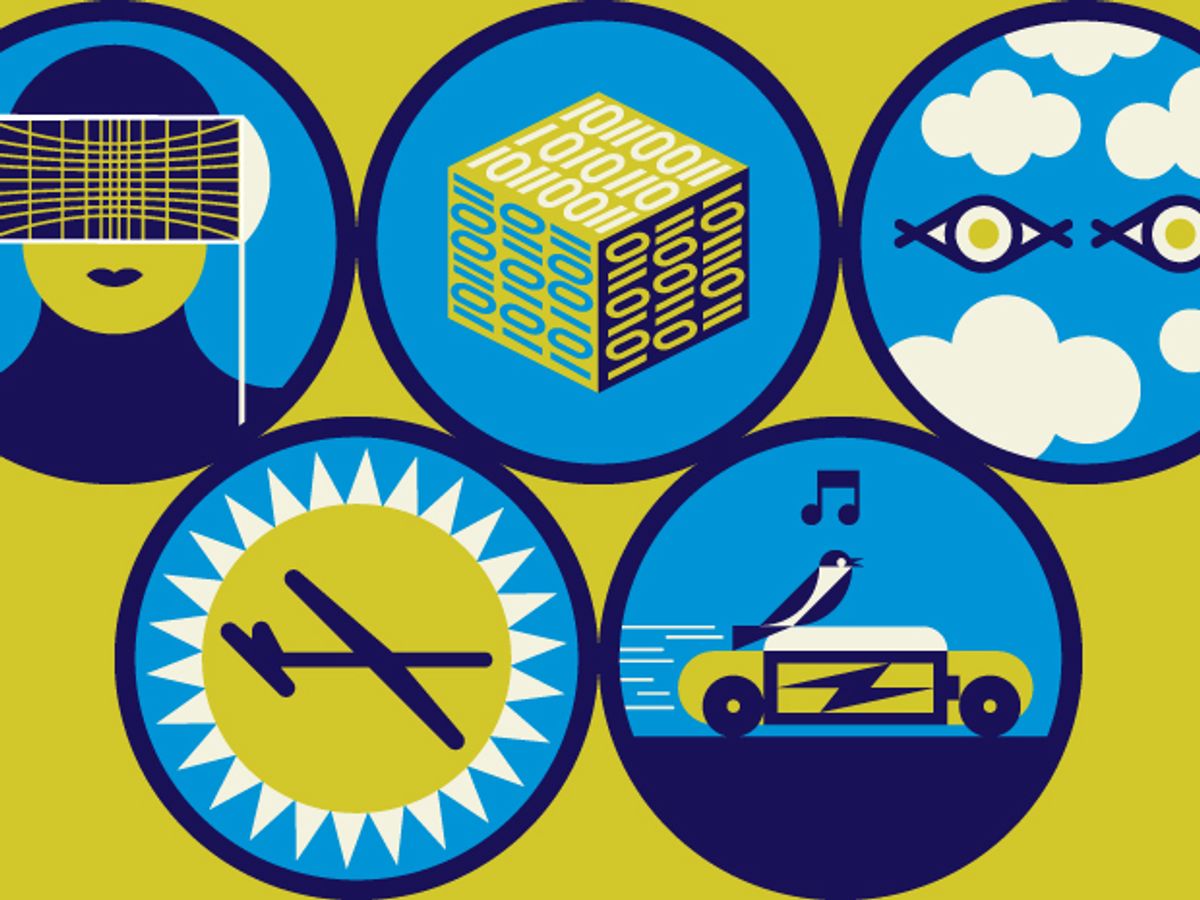Mostly Right! Updates on Our 2014 Predictions
Drones, virtual reality, and electric race cars all made news

It’s that time of year when we look back and take stock of what we’ve accomplished. At IEEE Spectrum that means seeing how well our predictions from last January’s tech forecast turned out. In our humble opinion, we did pretty well. Google and Facebook helped two of our predictions come true by spending big on Oculus Rift and Titan Aerospace. And two others, Formula E racing and 3-D memories, hit (or mostly hit) the milestones we forecast. We hope we can do as well with this year’s predictions.
Titans Vied for Titan
Google outbid Facebook for Titan Aerospace
Illustration: Greg Mably
IEEE Spectrum’s prediction that Titan Aerospace’s solar-powered “atmospheric satellites” (which are in truth fixed-wing aircraft) would make news [“Introducing Solara, the Atmospheric Satellite,” January 2014] was right on one hand and wrong on the other. In March of last year, rumors surfaced that Facebook was attempting to acquire the company—in hopes that Titan’s long-duration stratospheric drones could serve as high-altitude wireless relays, allowing millions to plug into the Internet without having to wait for conventional terrestrial infrastructure to be rolled out. Then in April, Google shouldered Facebook out of the way and purchased Titan for an undisclosed amount.
So there was quite a bit of news about Titan’s business dealings, if not its technology, early in the year. But in the months since Google acquired the company, there’s been little for anyone to report, as is only to be expected when a start-up gets absorbed by a tech giant in this way.
Electric Car Racing Runs Fast and Quiet
The first Formula E race ripped up the streets of Beijing
Illustration: Greg Mably
The Formula E racing circuit that IEEE Spectrum previewed last year [“Formula E Cars Race for All-Electric Glory,” January 2014] went pretty much as planned in its inaugural run on the streets of Beijing. The cars had lower top speeds but faster acceleration than Formula One cars, and they were safe—but not too safe.
Indeed, they provided the 70,000-odd attendees with the ideal crash. One of the two leaders bumped the other, went flying into a crash barrier, and landed upside down. Its driver emerged angry but unscathed. A third driver, Audi Sport ABT’s Lucas di Grassi, took first place.
The only thing lacking was noise. A Formula E car puts out a modest 80 decibels, like a hair dryer, compared with the gas-burning Formula One car’s 130 to 140 decibels, which is somewhere between a jackhammer and a jet engine. The organizers addressed the deficiency, if such it was, by supplying music.
Formula E is supposed to overcome the golf-cart image of electric cars, but that image has already been revised. In October, Tesla Motors previewed a dual-motor version of its all-electric Model S, which goes from 0 to 60 miles per hour (97 kilometers per hour) in about 3.6 seconds. The final version is supposed to do it in 3.2 seconds—very much on par with what Formula E cars can manage.
3-D Memory on the Rise
Vertical designs for more density and bandwidth are getting off the ground
Illustration: Greg Mably
Turning lines of memory cells on their side, so that they stand straight up, lets chipmakers save money by packing more bits into a given space. Last year, we predicted that 2014 would be the banner year for such 3-D memory [“Chipmakers Push Memory Into the Third Dimension,” January 2014]. And we were partly right.
Samsung already had a 3-D NAND flash-memory chip for data centers under its belt. In May, the company released a second offering, targeted at high-end PC users. These chips soon found their way into consumer-level solid-state drives, but less was heard from the other memory makers that aimed to release their first 3-D NAND products in 2014. Still, momentum is building: In November, Intel announced that it, too, has plans for the technology.
We also predicted that 2014 would be a big year for a vertical sort of dynamic RAM. Boise, Idaho–based Micron Technology has developed the Hybrid Memory Cube (HMC), a pile of DRAM chips that talk via chunky connections to a logic chip on the bottom of the stack. Micron hoped these designs would go into full production in 2014. But testing took longer than anticipated, says the company’s HMC technology strategist, Mike Black. He says production should ramp up by the middle of this year.
Oculus Rift: It’s getting better with time
The new dev kit from Oculus VR bodes well for the future of virtual reality
Illustration: Greg Mably
Oculus VR, which makes the best consumer virtual-reality headset that IEEE Spectrum’s editors have ever experienced, had a very big year in 2014. And we weren’t the only ones impressed with this hardware: Facebook acquired the entire company in July for US $2 billion.
The latest Oculus Rift development kit improves substantially on the one described in these pages a year ago [“Oculus Rift Takes Virtual Reality Mainstream,” January 2014]. It features a higher-resolution, active-matrix organic LED screen with faster response times, new sensors that can track the position of your head (not just where you’re looking), and various updates that reduce latency by 50 percent.
Spectrum got some eyes-on time with a prototype at the 2014 Consumer Electronics Show, in Las Vegas, and we found the experience a lot more immersive and a lot less virtual than what the preceding model provided.
Oculus is exploiting the consumer-electronics industry’s rapid development cycle to improve its product. In September, Oculus and Samsung announced a collaboration on a virtual-reality headset based on the screen of Samsung’s Galaxy Note 4. Although there is no official timetable for when this gadget will be ready for sale, our guess is that the long-awaited commercial release of the Oculus Rift—with even better hardware than what we tested—will take place sometime this year.
Snooping Eyes in the Skies
Small drones remain on privacy advocates’ radar
Illustration: Greg Mably
IEEE Spectrum can pat itself on the back for predicting that concerns over drones and privacy [“Would You Shoot Your Neighbor’s Drone?,” January 2014] would continue to simmer in the United States throughout 2014. “I don’t like the fact that someone I don’t know…can pick up, if they’re a private citizen, one of these drones and fly it over my property,” said Supreme Court Justice Sonia Sotomayor at Oklahoma City University’s law school in September. “That type of technology has to stimulate us to think about what is it that we cherish in privacy and how far we want to protect it and from whom.”
Shortly afterward, California lawmakers enacted a bill to help thwart paparazzi who use camera-carrying drones. They also fretted about other forms of intrusive robotic gadgetry yet to be devised. An analysis of the bill from the California Senate’s Rules Committee reads in part: “These advancements will open new avenues of innovation and productivity for our society, but will also have the potential to erode our sense of privacy.”
And as this issue went to press, the White House was preparing an executive order requiring federal agencies to report on their use of drones and the surveillance data they collect.
Despite all this, ever more folks sought camera-carrying drones to record themselves [see “Flying Selfie Bots,” in this issue].
 Illustration: Greg Mably
Illustration: Greg Mably Illustration: Greg Mably
Illustration: Greg Mably Illustration: Greg Mably
Illustration: Greg Mably Illustration: Greg Mably
Illustration: Greg Mably Illustration: Greg Mably
Illustration: Greg Mably